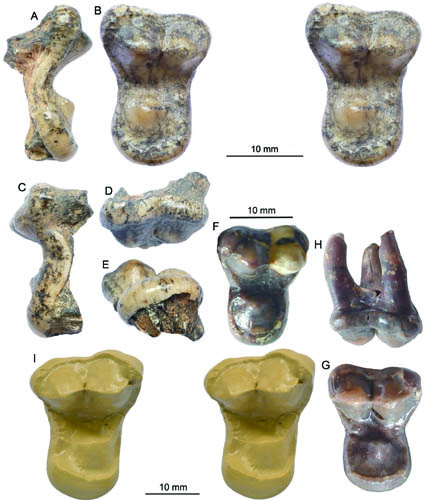| Location: Home > Research > Research Progress |
| New Amphicyonid Material Found from the Early Miocene of Central Nei Mongol |
|
Straddling between Europe to the west and North America to the east, Asia has long been suspected to be either a source of certain Cenozoic mammals that, thus far, are only found in Europe and/or North America, or a “jumping board” to and from the continents of destination as they disperse. Temnocyonine and haplocyonine amphicyonids (beardogs) are such an example that have been discovered both in Europend and North America, but remained absent in Asia. A newly discovered amphicyonid from the Early Miocene of central Nei Mongol, reported in the latest issue of Vertebrata PalAsiatica, filled in the long-expected Asian gap, offering new material for studies of Holarctic zoogeography. The new specimen is an isolated left upper molar collected from the Lower Red Mudstone Member of Aoerban Formation in Sonid Zuoqi, Xilinhot League, central Nei Mongol on August 8, 2015. With the exception of the missing roots, it is almost perfectly preserved, missing only the anterior rim of the enamels at the waist. As shows signs of only minor wear at the apex of the metacone, it represents that of a young adult. The new molar is strikingly similar to Haplocyonoides mordax and Temnocyon percussor with its dumbbell-shaped M1 outline, reduced parastyle, isolated protocone by a surrounding cingulum, and extreme reduction of pre- and postprotocristae. This molar is highly diagnostic of European haplocyonine or North American temnocyonine, two subfamilies of beardogs that have long been known in those continents but notably absent in Asia. Temnocyoninae and Haplocyoninae are peculiar lineages of amphicyonids, with hypercarnivorous dentitions and in some species, digitigrade posture. Members of these groups typically have a very trenchant lower molar battery that align their main cusps in a single row to facilitate shearing function and associated narrow, high-crowned premolar series. “Given the limited material at hand, we tentatively refer the new Chinese fossil to the European Haplocyonoides cf. H. mordax because of their similar size and age relationship”, said lead author Dr. WANG Xiaoming, a visiting professor of Institute of Vertebrate Paleontology and Paleoanthropology (IVPP), Chinese Academy of Sciences, and a senior curator of Natural History Museum of Los Angeles County, “if this identification is correct, our new record thus fills a large gap in the geographic distribution of the haplocyonines and represents an excursion of this rare subfamily from Europe, and confirms, once again, Asia has much to offer in our understanding of Holarctic zoogeography”.
Fig.1 Haplocyonoides cf. H. mordax (A−E) from Aoerban, Nei Mongol, Haplocyonoides mordax (F−H), and Temnocyon percussor (I) from Nebraska. (Image by WANG Xiaoming) Contact: WANG XIaoming Email: xwang@nhm.org Institute of Vertebrate Paleontology and Paleoanthropology, Chinese Academy of Sciences, and Natural History Museum of Los Angeles County |
